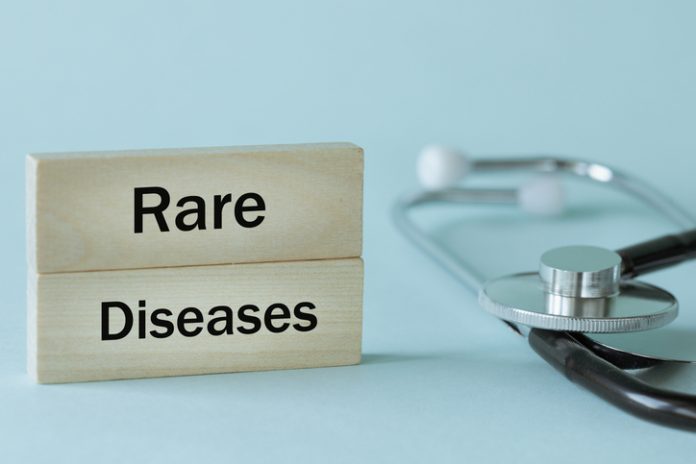U.S. House members introduced bipartisan legislation to reverse sanctions on small-molecule medicines in early February, providing new hope for people with rare diseases.
Proposed by Reps. Greg Murphy, M.D. (R-NC), Don Davis (D-NC), and Brett Guthrie (R-KY), the Energy and Commerce Committee Health Subcommittee chairman, the Ensuring Pathways to Innovative Cures (EPIC) Act would reverse the nine-year price limit placed on small-molecule drugs under the Inflation Reduction Act (IRA), re-aligning negotiation timelines with biologic, larger-molecule drugs.
‘Pill Penalty’ Inhibits Innovation
The IRA’s “pill penalty” has already resulted in some investors withdrawing funding from small- molecule programs that provide hoped-for therapeutics for rare disease patients.
“Small molecule drugs are critical therapies that Americans with cancer, neurological conditions, and other debilitating diseases rely on every day,” said Murphy in a press release, on February 1. “The IRA’s price-fixing scheme shifts research and development away from these life-saving medications, ultimately leaving patients with fewer treatment options. …Shortsighted proposals such as the ‘pill penalty’ inhibit meaningful strides to lower drug costs and reduce access to life-saving treatments for those most in need.”
IRA Shortened Timeline
The passage of the IRA in 2022 forced changes in Medicare price negotiations for large and small-molecule drugs.
Previously, after Food and Drug Administration approval, most small molecule drugs faced implementation of price controls after 11 years plus two years of price negotiations. The 13-to-14-year timeline allowed companies a longer period to recoup research and development costs and gain profit before competing with generics.
Under the IRA, price controls are now implemented after seven years plus two years of price negotiations, significantly reducing market interest in research and development for these drugs.
‘Investment Resources Fleeing’
Rare disease programs are especially affected by stricter price controls on small-molecule drugs, Evan Kozlow, director of operations and communications at the Rare Access Action Project (RAAP).
“Even though a limited exemption for rare therapies was included in the [IRA], the implementation is problematic because it eroded the incentives of the seminal Orphan Drug Act,” said Kozlow. “Since the bill’s passage, we have seen the closure of rare programs, investment resources fleeing to other therapeutic areas, and market uncertainty caused by federal policy- making.”
Rare diseases affect as many as 30 million Americans and are primarily treated with small-molecule drugs. “Congress made a clear statement on prioritizing rare disease research when the Orphan Drug Act was passed in 1983,” said Kozlow.
Price Controls Raise Treatment Costs
Rare disease patients are not the only group affected. The IRA’s controls on drug programs will impact treatment costs for other patients and taxpayers, says Joel White, president of the Council for Affordable Health Coverage (CAHC).
“The IRA creates incentives to develop more products that are infused or injected in physician offices or hospitals while reducing incentives to make more pills,” said White. “This has profound implications.”
While oral medications can easily be taken at home, infused and most injected products must be administered by doctors or nurses.
“Driving people to these products adds costs,” said White. “For patients, this is 20 percent of the cost of the drug, which is typically much more expensive than a pill, and 20 percent of the fee charged by the doctor or hospital.”
‘Creates Barriers to Care’
Furthermore, the IRA has driven disparity of care in specific populations, says White.
“Many patients in rural, low-income, and minority communities lack convenient access to doctors and hospitals, so the pill penalty also creates barriers to care,” said White.
The CAHC predicts an influx of patients to hospitals and clinics instead of pharmacies, intensifying current health care worker shortages.
Eliminating Penalty ‘Critical’
The RAAP called the proposed EPIC Act “a major step towards repairing the harm that the IRA was causing in innovation and the orphan drug pipeline,” in a February 5 press release. “The IRA missed the mark entirely for the rare disease community.”
“Eliminating the pill penalty is critical to reducing costs and improving access,” White said. “We shouldn’t pretend Congress got the law perfect. There are commonsense changes to be made, and the bipartisan EPIC Act, which would correct the pill penalty, is one of them.”
Moving Forward
Another bipartisan, bicameral bill, the ORPHAN CURES Act, introduced by Reps. John Joyce, M.D. (R-PA) and Wiley Nickel (D-NC) and Sens. John Barrasso (R-WY), and Thomas Carper (D-DE), would change the incentive structure within the IRA and encourage investment in follow-on orphan drug development, says Kozlow.
“It is possible that there will be bipartisan support for other solutions to protect subsequent
orphan indications,” Kozlow said. “Reversing IRA’s damaging incentives will benefit the thousands of patients currently suffering from rare diseases for which no treatments exist.”
RAAP is urging Congress to return the Orphan Drug Tax Credit to its original 50 percent of qualified research and development costs through legislation to stabilize and protect innovation in rare disease research. The group also wants to make permanent the priority review vouchers set to expire after September 30, 2024, disappearing completely in the fall of 2026.
“These vouchers allow companies to explore pediatric rare diseases, and to sell those vouchers upon FDA approval,” said Kozlow. “This has created a significant incentive for continued investments into pediatric rare disease.”
Ashley Bateman (bateman.ae@googlemail.com) writes from Virginia.





















